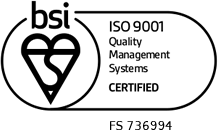Manufacturing and manufacturing processes are as vast and varied as manufactured products themselves. New materials and new engineering techniques are constantly being introduced into new, innovative products, and manufacturing processes themselves need to keep pace. One material type that gets utilised more than most are piezoelectrics.
Piezoelectic Materials in Manufacturing
While we may never see every day products being made, piezoelectric sensors keep a careful eye on the whole process to ensure that we receive the highest quality products and that as little as possible is wasted during the manufacturing process. This can range from flow sensors that measure and ensure the correct proportions of chemicals, food or building materials that are being combined, positioning or weighing sensors that ensure the products are in the correct place and are of the correct size, through to non-destructive measurement systems that make sure there are defects in the final products.
The manufacturing sector is a broad area of applications for piezoelectric materials. Various industries make different use of piezoelectric components, which pose a challenge in separation of the disciplines for better analysis.
Applicability of piezoelectric elements in manufacturing can be properly divided into three main sectors : ultrasonic material processing, inspection technologies, and automation.
Ultrasonic material processing
So-called sonochemistry is the application of ultrasonically caused acoustic cavitation for chemical reactions and processes occurring in liquid. It is another area of application for piezoelectric transducers.
The majority of applications of ultrasound phenomena in material processing procedures are related to the chemicals industry. For instance, homogenizing of liquids can be done with an ultrasonic device. It is used to reduce small liquid or solid particles in a liquid in order to improve uniformity and stability. This can be also achieved by using of piezoelectric based micro-mixers, having a big potential also in high volume production, by means of scaling out of the manufacturing process.
The de-agglomeration and dispersion of solids into liquid are also important ways of using ultrasound. Due to ultrasonic cavitation, agglomerated particles are dispersed into single pieces. In this way, powders are mixed into liquids to fabricate products such as paint, shampoo, ink or beverages.
Another group of products, including cosmetics, lubricants or fuels are using ultrasonic-based forces for dispersing two or more liquids into such emulsions.
Ultrasound is also advantageous in the field of wet milling and grinding in order to produce high quality slurries or micro and nano-size materials, for instance calcium carbonate or ceramics.
The next process that is realizable with piezoelectric generators is cell disintegration, which can be applied for instance to release starch or sugar from a cell structure. It can be used for organic matter conversion processes, for instance in ethanol production from biomass.
High-intensity ultrasound is also employed for extraction of proteins and enzymes from cells and particles. Other chemical processes achievable by ultrasonic devices, include trans-esterification of vegetable oils and animal fats into biodiesel, or liquid degassing.
In the field of materials processing, ultrasonic cleaning can also be included, which uses ultrasonic power to remove oil, grease, dust or soaps. It is environmentally friendly and is applicable to continuous materials, such as tanks, tubes, cables, and wires or tapes.
Ultrasonic welding is an industrial technique whereby high-frequency ultrasonic vibrations are used to weld objects together, usually plastics, and especially for joining dissimilar materials. Ultrasonics can also be used to weld metals, such as aluminium, copper, and nickel.
Inspection Technologies
Non-destructive testing (NDT), also called non-destructive evaluation (NDE) and non-destructive inspection (NDI), is testing that does not destroy the test object. Ultrasonic non-destructive testing is often performed on steel and other metals and alloys, though it can be used on concrete and other materials such as composites. It is the major non-destructive testing technique used in industry.
Inspection technologies employ piezoelectric materials in a number of ways.
One example is utilizing ultrasonic transducers for evaluation of weak spots in metallic components such as welds, similar to non-destructive testing technologies. Another example is using ultrasound for leak detection on bottles and cans.
A completely different approach of using piezo-elements for inspection is applying them in positioning control devices.
It is widely used in the semiconductor manufacturing industry (see below) for product quality inspection as such devices offer nanometre positioning accuracy.
Automation
A large and growing field of application for piezoelectric materials is industrial automation.
In the form of sensors, they can be used across many industries. For instance, they can be used for distance sensing or product detection on a production line. They can also be used as level measurement devices, or both gas and liquid flow rate sensors.
Moreover, there are also piezoelectric valves and pumps available. Another usage possibility is vibration damping, which is of great interest in the semiconductor industry.
Since automation is continuously shifting toward wireless operation, piezoelectric radio frequency transducers and filters are also applicable for remote automation units.
The Semiconductor Industry
In the field of manufacturing, special emphasis has to be put on the roles of piezoelectrics in the semiconductor industry.
Indeed, the semiconductor industry puts a premium on high-position resolution and speed.
Silicon wafers are getting larger and larger, and chip features are ever smaller and closer together. Storage media are also getting more dense.
Equipments that fabricate such devices must be speedy and precise.
Semiconductor process technologies that utilize e-beam, ion beam, DUV and X-ray, all face such pressures : stages must traverse a 300-mm diameter silicon wafer at high speed, narrow in on a specific region, and perform ultra-high resolution work, with high position stability.
Traditionally, the approach to synthesizing precise but speedy moves has been to combine coarse positioning, driven by a mechanical screw (linear servomotor), and fine positioning, driven by traditional piezo actuators, able to resolve distances in the tens of nanometres.
Recently, a full piezoelectric technology has emerged, which can combine the performance of a high-speed coarse drive, with a high resolution stage.
In this technology, piezo-ceramic elements are used to create a device that operates as a “ceramic servomotor”.
Moreover, ceramic servomotor technology is aimed to achieve the top level of performance required in today’s semiconductor market, and is well suited for all semiconductor manufacturing processes. For instance, Nanomotion’s ceramic servomotors are available in vacuum, UHV, and non-magnetic configurations, and are used extensively in applications related to the manufacturing of integrated circuits, and other semiconductor devices.



